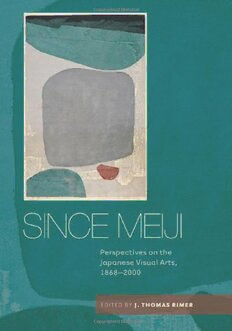
Since Meiji : perspectives on the Japanese visual arts, 1868-2000 PDF
Preview Since Meiji : perspectives on the Japanese visual arts, 1868-2000
(cid:2)(cid:3)(cid:4)(cid:5)(cid:6)(cid:7)(cid:8)(cid:6)(cid:3)(cid:9)(cid:3) Perspectives on the Japanese Visual Arts, 1868–2000 . EDITED BY J THOMAS RIMER Since Meiji Since Meiji Perspectives on the Japanese Visual Arts, 1868–2000 edited by J. Thomas Rimer translations by Toshiko McCallum University of Hawai‘i Press Honolulu © 2012 University of Hawai‘i Press All rights reserved Printed in the United States of America 17 16 15 14 13 12 6 5 4 3 2 1 Library of Congress Cataloging-in-Publication Data Since Meiji : perspectives on the Japanese visual arts, 1868–2000 / edited by J. Thomas Rimer ; translations by Toshiko McCallum. p. cm. Includes index. ISBN 978-0-8248-3441-8 (hardcover : alk. paper) ISBN 978-0-8248-3582-8 (pbk. : alk. paper) 1. Art, Japanese—1868– I. Rimer, J. Thomas. II. McCallum, Toshiko M. (Toshiko Miyabayashi). N7354.5.S56 2011 709.52’0903—dc23 2011026061 Publication of the volume was supported by a grant from the Kajima Foundation. University of Hawai‘i Press books are printed on acid-free paper and meet the guidelines for permanence and durability of the Council on Library Resources. Designed by Mardee Melton Printed by Sheridan Books, Inc. For Alexandra Munroe Who continues to do so much to allow the greater public to experience modern Japanese art Contents Preface ................................................. ix Introduction J. Thomas Rimer ..................................... 1 I. Painting and the Allied Arts: From Meiji to the Present 1. Western-Style Painting: Four Stages of Acceptance Emiko Yamanashi ....................................... 19 2. Japanese Painting from Edo to Meiji: Rhetoric and Reality Ellen P. Conant ......................................... 34 3. The Expanding Arts of the Interwar Period Gennifer Weisenfeld ..................................... 66 4. Sensō Sakusen Kirokuga: Seeing Japan’s War Documentary Painting as a Public Monument Mayu Tsuruya .......................................... 99 5. From Resplendent Signs to Heavy Hands: Japanese Painting in War and Defeat, 1937–1952 Bert Winther-Tamaki ................................... 124 6. How Gendai Bijutsu Stole the “Museum”: An Institutional Observation of the Vanguard 1960s Reiko Tomii ........................................... 144 7. Fashion Altars, Performance Factors, and Pop Cells: Transforming Contemporary Japanese Art, One Body at a Time Eric C. Shiner .......................................... 168 viii | Contents II. Japanese Art of the Period in Its Cultural Context 8. The Creation of the Vocabulary of Aesthetics in Meiji Japan Michael F. Marra ....................................... 193 9. Okakura Tenshin and Aesthetic Nationalism John Clark ............................................ 212 10. Japanese Art Criticism: The First Fifty Years Mikiko Hirayama ...................................... 257 III. Individual Forms of Expression 11. Sculpture Shūji Tanaka .......................................... 283 12. Can Architecture Be Both Modern and “Japanese”? The Expression of Japanese Cultural Identity through Architectural Practice from 1850 to the Present Jonathan M. Reynolds .................................. 315 13. The Modern Japanese Garden Toshio Watanabe ....................................... 340 14. Japanese Prints 1868–2008 Lawrence Smith ........................................ 361 15. Aspects of Twentieth-Century Crafts: The New Craft and Mingei Movements Chiaki Ajioka .......................................... 408 16. Japanese Calligraphy since 1868 Stephen Addiss ......................................... 445 17. Adoption, Adaptation, and Innovation: The Cultural and Aesthetic Transformations of Fashion in Modern Japan Audrey Yoshiko Seo ..................................... 471 Contributors ........................................... 497 Index ................................................. 501 Plates follow pages 150, 326, and 470 Preface This volume was first planned to serve as the third volume in a projected series of three on the history of Japanese art, under the general editorship of Professor Samuel Morse, with the assistance of Quitman Phillips and myself. It is the first to be published. The subject of Japanese art and its shifting parameters after the beginning of the Meiji period is an extremely complex one, and the subject can be approached from a number of angles. In the end, seventeen authors, from both the scholarly and the museum fields, enthusiastically agreed to make their own contributions to this volume, and the narra- tive they present can in many ways be regarded as a mirror in which so much of Japanese cultural, social, and even political history of the period can find reflection. Many other points of view could theoretically be incorporated as well, and it is with regret that given the length of the present volume, it was not possible to include the contributions originally planned for Brenda Jordan on Kawanabe Kyōsai and his Western enthusiasts, or Ryûichi Kaneko’s essay on the development of Japanese photography. Fortunately both of these scholars have written eloquently on these subjects elsewhere. It is a pleasure for me to thank so many friends and colleagues for the many efforts they have undertaken to help bring this book about. First of all, I owe a special debt of thanks to Mrs. Toshiko McCallum, whose translations and considerable editorial assis- tance have done so much to make this book a reality. Ms. Maggie Assad provided expert editorial skills in preparing the manuscript. I would like to thank as well Professors Ken- dall Brown, Kathy Harper, and Donald McCallum for a number of cogent and thoughtful suggestions and insights that have materially improved the manuscript. In addition to the generous assistance from the Kajima Foundation, there have been a number of sources helping to provide funds toward this publication. The Clark Center for Japanese Art in Hanford, California, contributed funds to underwrite the translations of articles originally written in Japanese, and the Paul I. and Hisako Terasaki Center for Japanese Studies at UCLA contributed funds toward the editing of the individual essays. Finally, I want to offer special thanks for the efforts made by our editor at the Univer- sity of Hawai‘i Press, Patricia Crosby, who has been unstinting both in her enthusiasm and her efforts to see this complex project through. Drew Bryan, our scrupulous copy editor, Susan Stone, who prepared the index, Lori Paximadis, who corrected the proofs, and Cheri Dunn and other members of the staff of the University of Hawai‘i Press have also been also extremely helpful.
